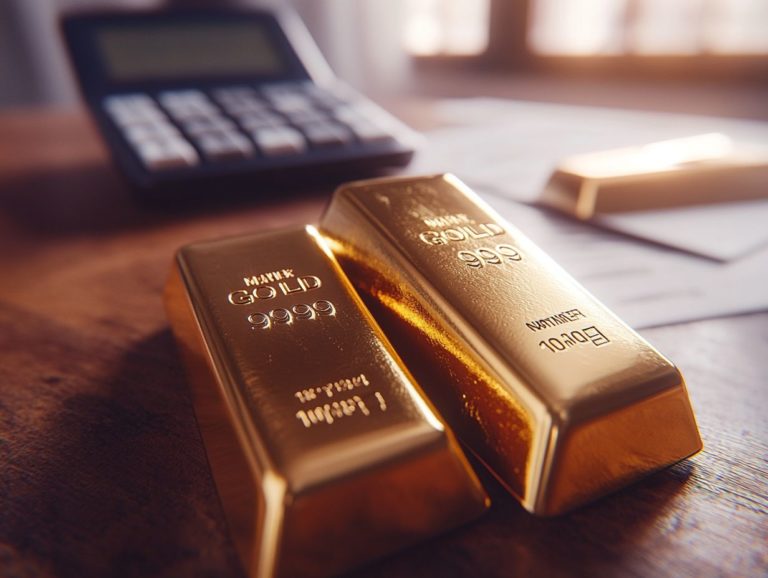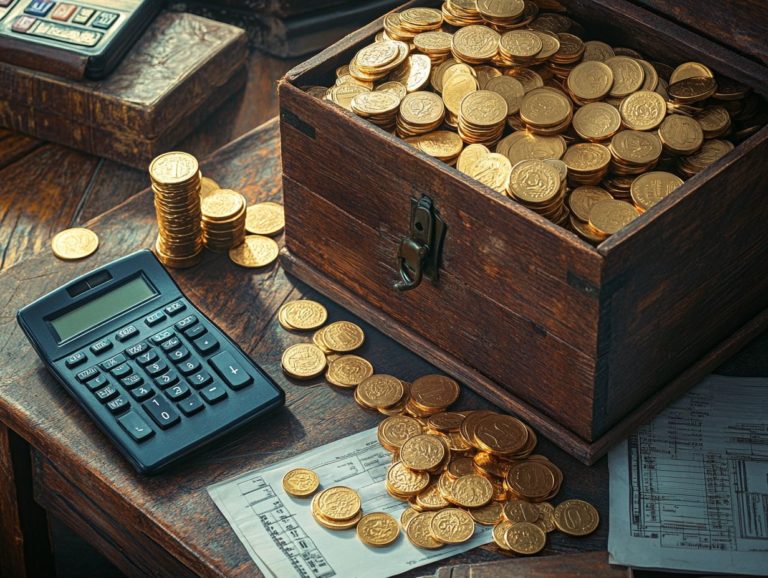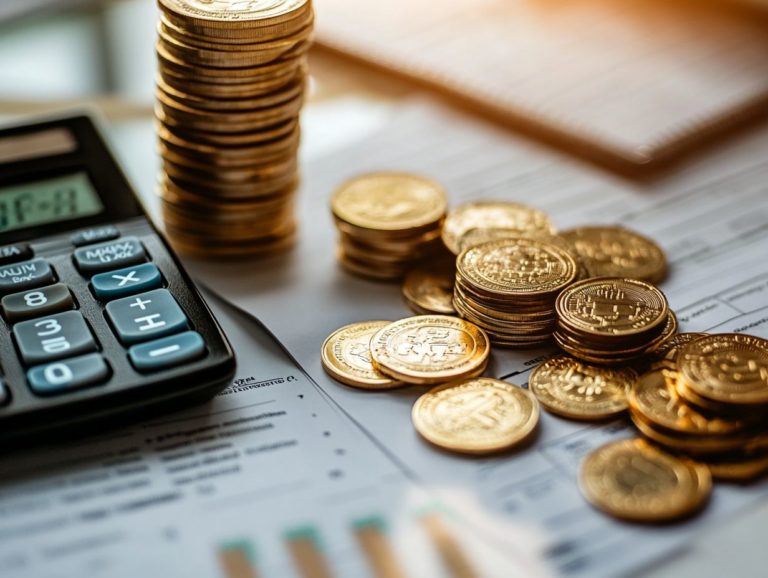Precious Metals and Taxes: A Beginner’s Overview
Investing in precious metals can be exciting and profitable, but understanding the tax landscape is crucial! By grasping what precious metals are and the various types available like gold, silver, and platinum you lay the groundwork for informed investing.
This article delves into the tax implications associated with buying, selling, and inheriting these valuable assets. It also presents strategies to optimize your investment through tax-advantaged accounts like IRAs and 401(k)s.
Regardless of whether you re an experienced investor or just starting your journey, this guide will serve as your compass in navigating the intricate relationship between precious metals and taxes.
Contents
- Key Takeaways:
- Types of Precious Metals
- Tax Considerations for Buying and Selling Precious Metals
- Reporting Requirements
- Tax-Advantaged Ways to Invest in Precious Metals
- IRA and 401(k) Options
- Tax Implications of Inherited Precious Metals
- Frequently Asked Questions
- What are precious metals?
- How are precious metals taxed?
- Do I have to pay taxes when I buy precious metals?
- What is the difference between long-term and short-term capital gains tax on precious metals?
- Are there any tax benefits to investing in precious metals?
- How can I reduce my tax liability on precious metal investments?
Key Takeaways:

- Precious metals, such as gold, silver, and platinum, can be valuable investments, but it’s important to understand the potential tax implications when buying and selling them.
- When selling precious metals, be aware of capital gains tax and the reporting requirements for tax purposes.
- Investing in precious metals through a tax-advantaged account, such as an IRA or 401(k), can provide potential tax benefits and help diversify your portfolio.
What are Precious Metals?
Precious metals gold, silver, platinum, and palladium are treasures not just for their rarity but also for their unique properties. These characteristics make them exceptional physical assets for your investment portfolio. Historically, these metals have acted as a shield against inflation, serving as a reliable store of value. They provide a way to diversify your investments, especially during market fluctuations and geopolitical uncertainties.
Investing in precious metals presents a tangible alternative to conventional financial instruments, appealing to both seasoned investors and newcomers eager to safeguard their wealth from price volatility.
Each of these valuable resources boasts distinct characteristics that elevate their appeal. Gold, for instance, is lauded for its corrosion resistance and malleability. Meanwhile, silver shines with its industrial uses and high conductivity. The historical significance of these metals dates back to ancient civilizations, where they functioned as currency and symbols of power.
In today’s world, various market dynamics supply and demand, currency fluctuations, and economic conditions play a significant role in influencing their prices. You have the opportunity to explore multiple forms of investment in these metals, from coins and bullion bars to exchange-traded funds (ETFs). Understanding the nuances of each investment type is crucial for maximizing your potential returns.
Why are Taxes Relevant?
Understanding the relevance of taxes in the realm of precious metals is essential for you as an investor looking to improve your financial planning. Precious metals are often seen as alternative investments, and they come with unique tax implications that can significantly influence your overall investment strategies and returns.
It’s crucial for you to grasp how capital gains tax affects your gold and silver investments, along with other tax considerations that pertain specifically to the commodities market. Knowing these rules helps you keep more of your profits while ensuring you remain compliant with regulations.
You need to be mindful of how different types of transactions like buying and selling bullion versus numismatic coins, which are valuable due to rarity and demand rather than just precious metal content can lead to varying tax consequences. For example, when you sell precious metals, you might face short-term or long-term capital gains taxes, depending on how long you’ve held them. This necessitates a strategic approach to timing your transactions.
Consider using tax-deferred accounts, such as IRAs, as they can provide significant advantages, allowing you to shelter gains until you decide to withdraw them. Understanding these details is vital for managing the complex landscape of tax obligations tied to your precious metal investments.
Types of Precious Metals
The realm of precious metals presents a captivating array of options, including gold, silver, platinum, and palladium. Each is distinguished by its unique attributes and investment potential.
Gold continues to reign supreme as the most coveted metal for investment. It is celebrated for its stability and rich historical legacy as a symbol of wealth.
In contrast, silver tends to be more volatile, influenced by its various industrial uses. Yet, it offers compelling opportunities for both investment and practical application in fields like photography and solar energy.
Platinum and palladium may be less traditional, but they carve out their niches in the market, primarily due to their critical roles in parts used in cars and other industrial applications. This enriches the choices available for discerning investors like you.
Gold, Silver, Platinum, and More

Gold, silver, platinum, and palladium are the pillars of precious metals. Each offers unique investment avenues and distinct market behaviors.
You ll find gold often hailed as the ultimate safe haven, recognized for its enduring value and lower price volatility compared to silver.
In contrast, silver plays a dual role, serving both as an investment vehicle and an industrial metal. This creates intriguing market dynamics influenced by fluctuations in industrial demand.
Though platinum and palladium may not dominate the conversation, their growing importance in the automotive sector adds another layer of diversity to your precious metals portfolio.
The allure of gold is timeless, reflecting not just its intrinsic beauty but also its role as a hedge against inflation and economic uncertainties.
Historical events like financial crises often trigger spikes in gold prices. This reaffirms its reputation as a reliable asset.
Silver, meanwhile, carves out its significance across various industries, from electronics to renewable energy. This shapes its market trends and price movements.
As for platinum and palladium, their roles in catalytic converters have spurred recent demand, making them essential investments in a rapidly evolving automotive landscape, especially with the rise of electric vehicles.
By understanding these dynamics, you can confidently navigate the exciting world of precious metals!
Tax Considerations for Buying and Selling Precious Metals
Tax considerations for buying and selling precious metals are pivotal for investors like you. It is crucial to understand the implications of capital gains tax, as these can profoundly impact your net profits from transactions.
Understanding reporting requirements is vital for maintaining transparency and complying with tax regulations. This is especially important in markets characterized by price volatility, which can result in significant gains or losses.
Capital Gains and Losses
Capital gains and losses from selling precious metals can significantly impact your tax situation as an investor. When assets like gold or silver appreciate, the profits you realize upon selling them are generally subject to capital gains tax. This tax fluctuates based on your holding period and tax bracket.
On the flip side, recognizing losses can be a savvy strategy to offset those gains. This makes it crucial for you to grasp the intricacies of capital gains tax in the commodities market.
Short-term capital gains, applicable to assets held for one year or less, are taxed at your ordinary income rate. This can often be much higher than the long-term rate.
In contrast, if you hold an asset for over a year, you’ll benefit from long-term gains, which enjoy a lower tax rate, typically capped at 20%.
This distinction underscores the importance of timing in your investment decisions if you want to optimize your tax obligations.
To effectively manage your gains and losses, consider strategies like tax-loss harvesting. This involves selling underperforming assets to offset taxable gains from other investments.
Additionally, exploring the potential of 1031 exchanges or investing in tax-deferred accounts can further enhance your tax efficiency.
Understanding capital gains tax is vital to protecting your profits don t miss out! Ready to dive into the world of precious metals? Start your investment journey today!
Reporting Requirements
Understanding the reporting requirements related to precious metals is essential for maintaining compliance with tax obligations. As an investor, it s exciting to know what you need to track regarding necessary documentation and disclosures when buying or selling metals like gold or silver.
Market fluctuations can lead to significant capital gains or losses. Adhering to these requirements not only protects you from potential penalties but also ensures transparency in your investment activities.
This includes submitting IRS Form 1099-B, a document the IRS requires to report your sales and gains, for transactions exceeding $600. Timely completion of these forms is crucial, as delays could result in compliance issues. Keeping meticulous records of purchase prices, dates, and quantities simplifies reporting and aids in tracking your overall portfolio performance.
By understanding these protocols, you minimize the risk of audits and reinforce the integrity of your investment strategies. Accurate reporting boosts your confidence as an investor. You deserve clarity while navigating the precious metals market.
Tax-Advantaged Ways to Invest in Precious Metals

Tax-advantaged strategies for investing in precious metals present you with the opportunity to enhance your returns while keeping tax liabilities in check. By leveraging retirement accounts like IRAs and 401(k)s, you can hold physical assets such as gold and silver in a tax-deferred environment, which elevates your long-term investment approach.
These vehicles promote diversification within your portfolio and serve as a safeguard against inflation, making them particularly attractive for those cautious about market fluctuations.
IRA and 401(k) Options
IRA and 401(k) options for investing in precious metals offer unique tax advantages that can significantly elevate your investment portfolio. By incorporating tangible assets like gold or silver into these retirement accounts, you can enjoy tax-deferred growth, allowing your investments to compound over time without the burden of immediate tax implications.
This strategy diversifies your portfolio and shields you from inflation and market changes. These accounts typically permit a variety of approved precious metals, including gold, silver, platinum, and palladium, as long as they meet the specific fineness requirements set by the IRS.
Understanding eligibility is essential; not all retirement plans can accommodate investments in precious metals. It s wise to consult with your plan administrators to clarify your options. The tax benefits can be especially advantageous when you withdraw funds in retirement, as distributions may be taxed at a lower rate than ordinary income, ultimately enhancing your long-term returns.
Tax Implications of Inherited Precious Metals
The tax implications of inherited precious metals can pose unique challenges and opportunities for your financial planning. When you inherit assets like gold or silver, you ll need to deal with various tax rules that can significantly impact your overall wealth management strategy.
It s crucial to understand how these assets are valued and reported for tax purposes. This knowledge is key to ensuring compliance while maximizing the value of what you ve inherited.
How to Handle Inherited Precious Metals for Tax Purposes
Handling inherited precious metals for tax purposes demands careful attention to valuation and reporting requirements to ensure compliance. When you inherit assets like gold or silver, it’s crucial to determine their fair market value at the time of inheritance. This value will impact any potential capital gains tax a tax on the profit made when you sell an asset for more than you paid for it when you decide to sell. Proper documentation and a clear understanding of the specific reporting requirements will facilitate a seamless transition of these assets into your financial planning strategy.
Seek a professional appraisal to get an accurate monetary assessment, especially since fluctuating market rates can significantly affect the value. Maintaining a meticulous record of all relevant documents, from original purchase invoices to certificates of authenticity, is essential; these will be vital for any future transactions.
Don’t wait! Consulting a financial advisor or estate planner can unlock strategies to maximize your investment in these valuable commodities. You can explore options for storage, insurance, and eventual liquidation. Staying informed about current market trends is equally crucial, as it will guide your decisions on whether to hold onto or sell these assets.
Frequently Asked Questions

What are precious metals?
Precious metals are rare, naturally occurring elements that have high economic value. Examples include gold, silver, platinum, and palladium.
How are precious metals taxed?
Precious metals are subject to various taxes, including capital gains tax, sales tax, and inheritance tax. The specific tax rate depends on the type of metal and how it is acquired.
Do I have to pay taxes when I buy precious metals?
Yes, in most cases, you will have to pay sales tax when purchasing precious metals. However, certain states exempt precious metals from sales tax.
What is the difference between long-term and short-term capital gains tax on precious metals?
Long-term capital gains tax applies to profits from precious metal investments held for more than a year, while short-term capital gains tax applies to profits from investments held for less than a year.
Are there any tax benefits to investing in precious metals?
Yes, investing in precious metals can provide tax diversification in your portfolio. Certain retirement accounts, like a self-directed IRA, allow for tax-deferred or tax-free investment in precious metals.
How can I reduce my tax liability on precious metal investments?
One way to reduce tax liability on precious metal investments is to hold them in a tax-advantaged account, such as an IRA. Timing the sale of your investments to minimize capital gains tax can also help reduce your tax burden.
For more personalized advice, consult a financial professional today!













